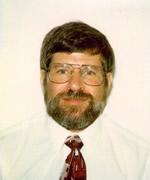Jory A. Pacht, Summer 2004
 The Other
Gulf of Mexico……………Mexico
The Other
Gulf of Mexico……………Mexico
I sometimes find it amusing that we call ourselves the Gulf Coast Section of the SEPM but when you look at our logo, it is apparent that we really only deal with a portion of the Gulf Coast. Our logo is a map extending from Florida to Texas. The Gulf Coast, however, doesn't stop at the Texas-Mexico border.
Obviously, much of the Gulf of Mexico is bordered by Mexico. Mexico is the fifth largest petroleum producer in the world and most of their oil and gas is produced from fields in and around the Gulf of Mexico. Oil was first found in Mexico in 1904. Since then 280 billion barrels OOIP and 230 TCF of OGIP have been found. Currently reserves are estimated by PEMEX at 40 billion Barrels of Oil and 76 TCF of gas. Mexico produces 3 million barrels of oil per day and 4.6 billion cubic feet of gas per day (Guzman, 2002). Much of this production has come from a middle Cretaceous atoll south of Tampico known as the Golden Lane. Some wells in this trend set world records when they produced in excess of 200,000 barrels of oil per day. PEMEX has a vibrant young geologic and geophysical staff and many of their personnel are eager for the kind of resources (ex. Research conferences) that GCSSEPM provides. They actually have geologists and geophysicists that are under 45 years of age.
And yet historically GCSSEPM has had relatively little to do with Mexico. There are few GCSSEPM members from Mexico and there is little mention of Mexico in any of our publications. This is something that has to change!!! GCSSEPM has to start thinking of itself as an international organization. As such we need to do more to reach out to Mexico.
We have already begun this effort. Mr. Victor Davila a Professor at UNAM (Universidad Nacional Autónoma de México), Mexico City; has agreed to serve as our business representative in Mexico. Victor teaches sedimentary petrology at UNAM and for several years ran a program in which PEMEX geoscientists took a series of short course at UNAM taught by both U.S. and Mexican scientists. Several of our members (Paul Wiemer, Rodger Slatt, and of course, yours truly) have taught some of these courses.
I see the appointment of a Mexican Business Representative, however, as only a starting point. We need to do more to recruit new members from the ranks of PEMEX Geoscientists. We need to begin thinking about joint U.S. Mexican scientific conferences. For example, PEMEX is exploring for the same Vicksburg and Wilcox play types in the Burgos Basin that we have drilled for years on the U.S. side of the border. Out in deep water, there have been persistent rumors that PEMEX is planning on drilling one of the largest structures in the Perdido Fold Belt, just south of recent U.S. discoveries in that trend.
I'm not the first one to try to encourage a U.S. geologic organization to foster better relationships between Mexican and U.S. geoscientists. Many AAPG members have worked very hard, with some degree of success to get Mexican scientists to present papers at the AAPG annual Convention and publish them in the AAPG Bulletin. Many Mexican scientists are now members of AAPG and more will continue to join. But GCSSEPM is ideally suited to encourage the technology transfer that would benefit both Mexican and U.S. geoscientists. GCSSEPM has published two Guidebooks on Mexico and several PEMEX employees presented papers in The South Texas Geological Society conference we helped organize. In addition we are a much smaller organization than AAPG and there is more scientific interaction on a one-on-one basis at our meetings.
Building bridges with Mexico is not just something we should do. It is something we have to do to continue to grow and expand our role in geoscience in the Gulf of Mexico and surrounding regions.
2004 Bob F. Perkins Research Conference
I'd like to use the remainder of my allotted space for an unabashed commercial for our upcoming Bob F. Perkins Research Conference Salt-Sediment Interactions and Hydrocarbon Prospectivity: Concepts, Applications, and Case Studies for the 21st Century. It has been nine years (1995) since we hosted a convention on salt tectonics. This conference was held just after the subsalt discoveries in the early 1990's when we were still learning about horizontal salt movement in the Gulf of Mexico. We now know quite a bit more, particularly about the relationship between salt tectonics and sedimentation in very deep-water. In addition, seismic tools, like pre-stack depth migration are far more routinely applied, than was the case back in 1995. Paul Post and the other Program Advisory Co-chairs have assembled an excellent series of papers and this conference will truly be an international event, with authors from Australia, Brazil, France, Great Britain, Norway, Poland, Scotland, as well as the United States. You view the abstracts online on our website at http://www.gcssepm.org/pubs/abstracts.htm. This conference is a must for anyone working deep-water Gulf of Mexico, West Africa or Brazil.
An oldie but a goodie...
An exploration manager goes to sleep one night and awakes to find himself before God in heaven. Since he was relatively young and in good health he asks God why he's in heaven. He's sure a mistake has been made. God wonders too and summons St Peter. They check the records and sure enough a mistake was made. The manager was called up way too early. He was sent back to earth and as he was going God told him: I feel bad about this mistake so in return I'm giving you a map which shows the location of all the earth's undiscovered oil and gas reserves. The manager examines the map then looks up and says: "Gee thanks God… But do any of these locations show amplitude anomalies?"
